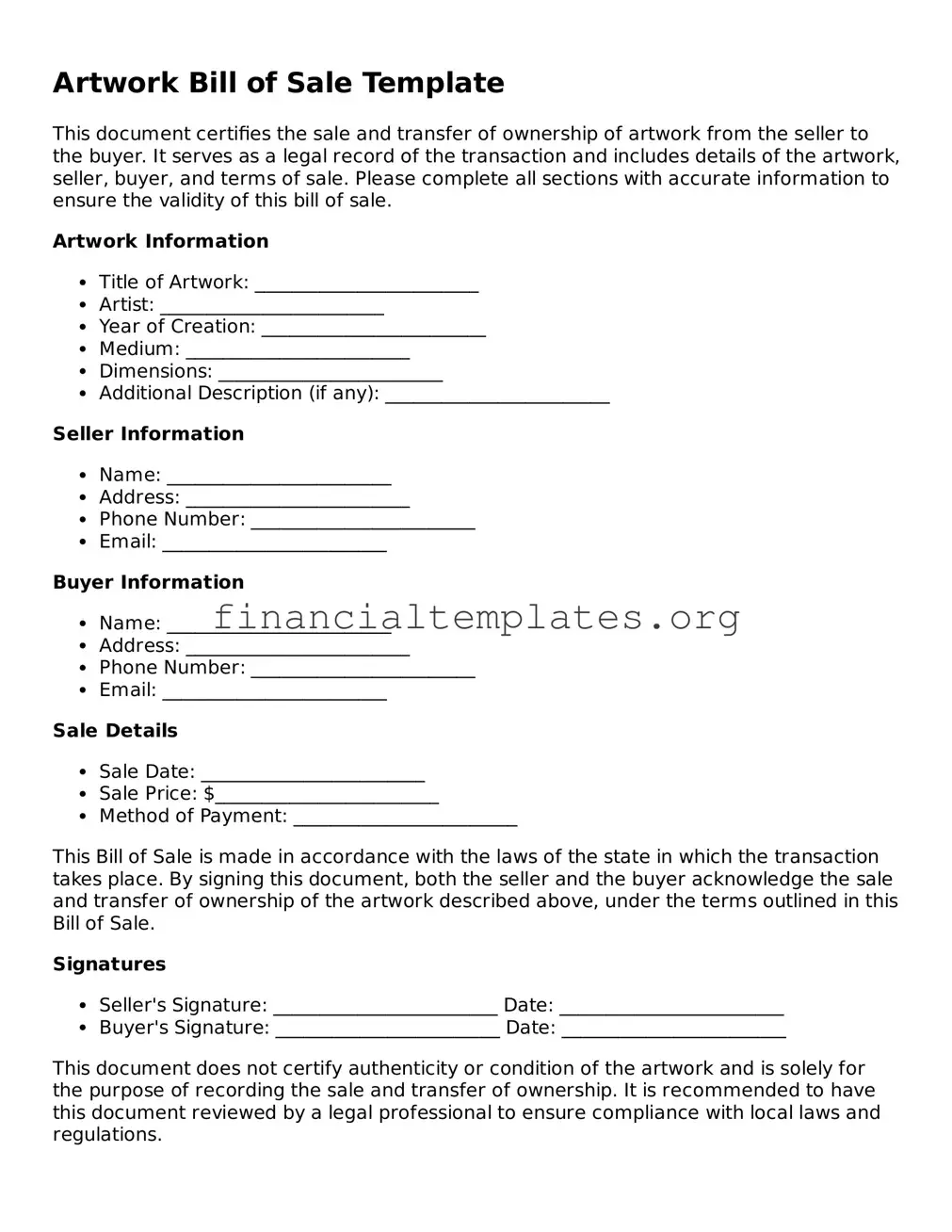Vehicle Bill of Sale forms share similarities with Artwork Bill of Sale forms, as they both serve as evidence of a transfer of ownership from seller to buyer. These documents typically include essential information such as the names and addresses of the buyer and seller, a description of the item being sold, and the sale price. However, while an Artwork Bill of Sale would detail the specifics of an art piece, a Vehicle Bill of Sale focuses on vehicle details like make, model, and VIN.
Real Estate Bill of Sale documents, while used in the sale of property, parallel the function of Artwork Bill of Sale forms in confirming the exchange of ownership. They both must clearly outline the transaction details, including a description of the sold asset and the agreed-upon price. The primary difference is that Real Estate Bill of Sales include more complex legal descriptions of property and may involve more detailed terms due to the higher value and regulations involved in real estate transactions.
Business Bill of Sale forms, much like those for artwork, establish a formal agreement regarding the sale of a business or its assets between two parties. These documents lay out the transaction’s specifics, including the sale amount and a detailed list of the assets being transferred, similar to how an Artwork Bill of Sale specifies the piece of art. The main distinction arises from the Business Bill of Sale often dealing with multiple assets or inventories and possibly outlining terms for transferring liabilities.
Firearm Bill of Sale forms function similarly to Artwork Bill of Sale forms by documenting the sale and transfer of ownership of an item—in this case, a firearm—from a seller to a buyer. Both forms should include essential transaction information such as the buyer’s and seller’s details, item description, and sale price. The significant difference lies in the specifics required, with a Firearm Bill of Sale likely including serial numbers and complying with legal regulations specific to firearm sales.
Equipment Bill of Sale documents are used when selling or purchasing equipment, much like Artwork Bill of Sales are used for artwork transactions. These documents secure the terms of the sale, recording details about the seller, buyer, item being sold, and the price. Equipment Bills of Sale, however, often contain specifications and conditions of the equipment, warranty information, and sometimes terms of payment, reflecting the practical nature of these assets compared to the more subjective value of art.
Pet Bill of Sale forms, though concerning the sale of animals, are thematically similar to Artwork Bill of Sale documents. Both acknowledge a change in ownership and include necessary details about the parties involved, the object of the sale, and the price. Specifics about the pet, such as breed, age, and health information, are analogous to the detailed description of artwork, including the creator, medium, and dimensions. However, the emotional attachment and care instructions with pets introduce unique considerations not typically relevant in art sales.
Boat Bill of Sale forms serve a similar purpose to Artwork Bill of Sale forms by evidencing the sale and transfer of ownership, but with a focus on watercraft. These documents detail the transaction, including the identities of the buyer and seller, a description of the boat, and the sale price, akin to an Artwork Bill of Sale. However, Boat Bills of Sale also deal with specific items like hull identification numbers and may require information about trailer and outboard motor details if included in the sale.
Furniture Bill of Sale documents operate under a premise similar to that of Artwork Bill of Sale forms by delineating the specifics of a sale between two parties. Both forms contain transaction details like the identities of the buyer and seller, a description of the sold item, and the price. The distinction lies in the nature of the items sold; furniture sales might detail condition, dimensions, and material, whereas artwork sales focus on the creator, medium, and provenance.
Intellectual Property (IP) Bill of Sale forms, although dealing with intangible assets, overlap with Artwork Bill of Sale forms in function. They both secure a record of the transfer of ownership from one party to another, detailing the parties involved, a description of the asset, and the transaction amount. The difference is in the asset type; IP Bill of Sale forms deal with rights like patents, trademarks, and copyrights, emphasizing legal descriptions of intellectual property over the physical characteristics of an artwork.
Collectibles Bill of Sale forms, much like those for artwork, document the sale and transfer of ownership of valuable collectible items. These documents capture critical details of the transaction, including the buyer’s and seller’s information, a description of the collectible, and the price. While specific items may vary greatly—from vintage toys to sports memorabilia—the focus on providing a comprehensive description and authenticating the item's value is a commonality shared with Artwork Bill of Sale forms.
